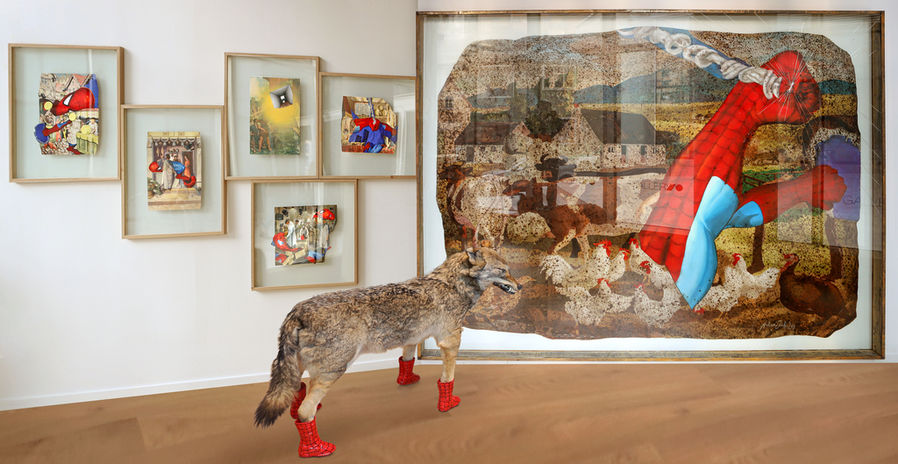During the period of March 25th – May 9th 2021, Gallery70 in Tirana exhibited the latest project by Ardian Isufi, entitled “You act like mortals in all that you fear, and like immortals in all that you desire”. Gallery70, a triangular space with a glass partition wall, integrates with the city, and both the visitors and casual passers-by can see from outside the gallery a collage of six paintings and an embalmed wolf, which are united by one element: Spider-Man or rather, pieces of him. Once a symbol of security for mankind, a capitalist myth worshipped by man, now Spider-Man crawls under the wolf’s feet, being worn by him like shoes.

Ardian Isufi articulates the concept of “the capitalist myth”, an idea generated by human creativity during the XXI century and the post-modernist period. For years Spider-Man was adapted from pop culture as a superhuman form, a power that aimed to protect humanity from danger. However, Ardian Isufi already sees it as a different concept from its origins and initial role. Today, Spider-Man is no longer treated as a myth, but a consumer product. The mysticism that characterized his nature, according to the author, has disappeared during capitalist realism and the uncertainty that roams around the world. Spider-Man has lost control of the world, but also of himself. He is found fragmented in the paintings of different epochs of time, in social situations unrelated to his function.
There are two motifs that accompany Spider-Man in each of the six paintings of the collage: he is never complete, thus unable to master his power. Second, he is always accompanied by surveillance cameras, regardless of the historical era in which he is located and the technological possibility of having cameras at that moment.
Ardian Isufi’s Spider-Man is dispersed in a lengthy time span collage, which starts from antiquity and seems to end somewhere during the Industrial Revolution. In the painting that seems to belong to the earliest period, people are amazed by a chamber that appears from the sky, hovering and featuring a screen. The chamber has partially emerged and intervenes with strong light in the lives of people who observe and react to this first display of technology.
In the pictures on the left, Roman merchants try to sell Spider-Man pieces, they weigh them and rate them for consumers, always monitored by cameras. Next to it, medieval traders continue their work undisturbed even though the face and other parts of Spider-Man partially occupy the market space and the cameras monitor from the kiosks. In another painting, workers of what looks like a factory are packing pieces of Spider-Man, while above it the bust of Spider-Man traverses the kitchen of a restaurant, where work continues at the usual pace.
The largest painting in the exhibition, positioned in front of the glass window, offers a pastoral landscape, peaceful and with farm animals who follow the life undisturbed by the arms of Spider-Man coming out of nowhere and traversing the life of the village. The glass that protects the painting is broken, just like the capitalist myth. In front of it, the embalmed wolf wears boots with Spider-Man skin and looks menacingly towards the entrance.
* Born in Tirana in 1973, author Ardian Isufi graduated in Graphic Arts at the Academy of Arts in Tirana, where he was later employed as a professor and dean of the Faculty of Fine Arts. Since 1995 he has been active in the international contemporary art scene as an artist, curator and art critic. Sensitive to public and social issues, his work deals with the position of the person and the reality that surrounds him, often with humor. Ardian Isufi has been awarded twice with the “Onufri” prize in the Visual Arts Competition, respectively with the second prize in 1996 and the third prize in 2005. He won first prize for Best Artist from the AIITC Foundation in 2006 and from the Zenit Gallery in 2007, among others.

